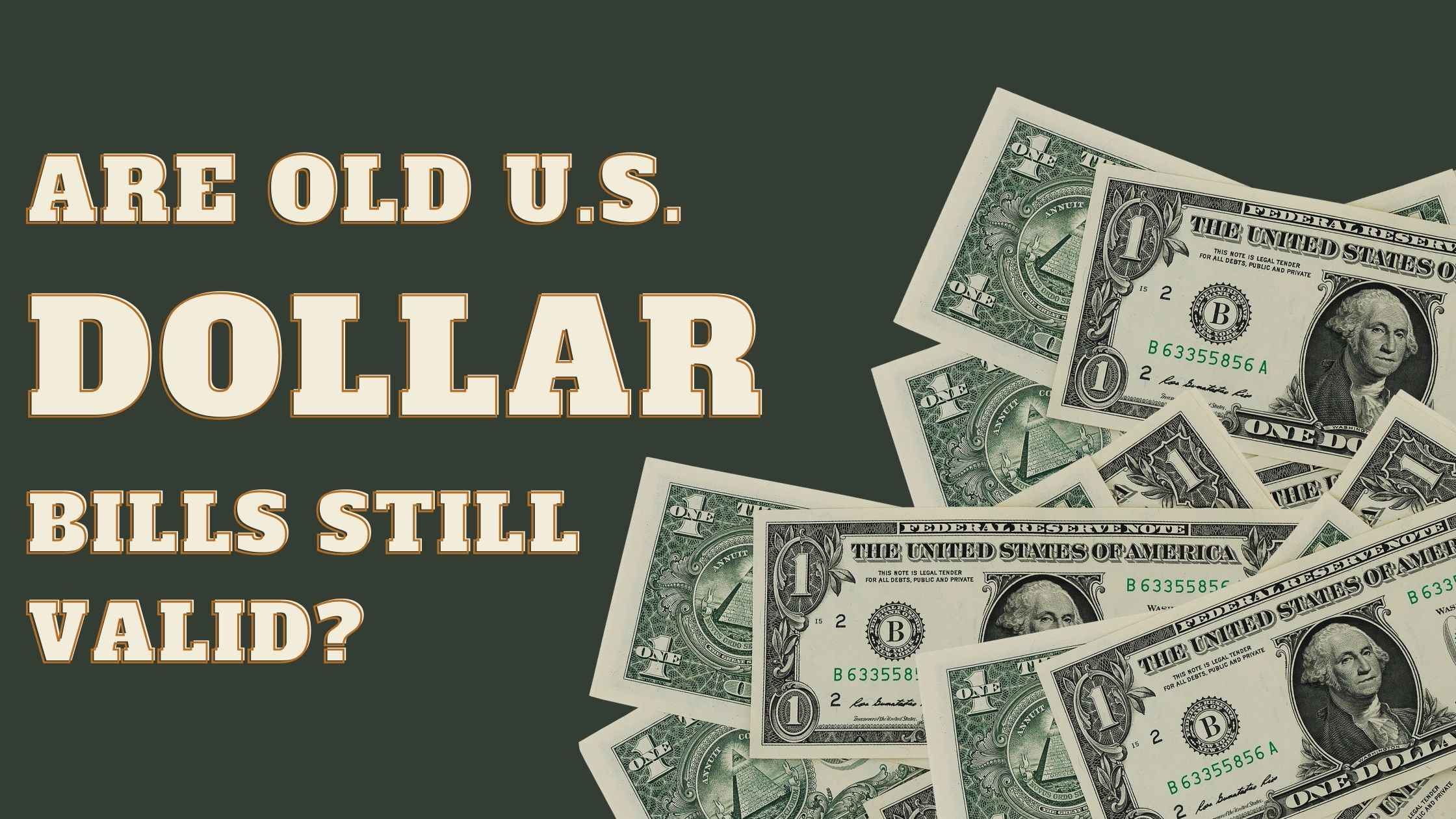There have been several incidents where old U.S. dollar bills were not accepted. Chaos has sprung over the refusal of some paper money exchangers to accept old U.S. dollar bills. This raises the question “Are Old U.S. dollar bills still valid?”
Especially for the last five years, people from around the world have been facing this problem. However, every dollar bill being a legal tender can be used to conduct financial transactions.
Now, let us jump into the article and understand the answer to the question in detail.
Are Old U.S. Dollar Bills Still Valid?

Credit: Photo by Emilio Takas on Unsplash
Yes, old U.S. Dollar Bills are still valid because they are Federal Reserve notes. All Federal Reserve notes remain legal tenders that are valid for payments which also includes old U.S. dollar bills. All circulating notes issued from 1861 to present at face value as legal tender.
As per 31 USC § 5103 –
“It is U.S. government policy that all designs of Federal Reserve notes remain legal tender, or legally valid for payments, regardless of when they were issued.”
Why Are Old U.S. Dollar Bills Still Valid?
Old U.S. dollar bills are still valid because all Federal Notes that have been issued since 1861 are valid at their face value. This means that dollar bills issued by the U.S. government that go as old as 1861 can still be redeemed at their face value, given that they are in circulation.
All old U.S. dollar bills (as old as dollar bills first issued in 1861 by the U.S. government) are legal tenders valid for payment. To fully understand why old U.S. dollar bills are still valid, you need to understand what legal tenders are.
All U.S. coins and currency issued by the U.S. government are known as legal tenders. Cash dollars, including old U.S. dollar bills that are still in circulation, are also considered legal tenders.
All Federal Reserve notes as well as notes from Federal Reserve Banks are treated as legal tenders. Old U.S. dollar bills are also Federal Reserve Notes, as mentioned earlier.
These notes can be used for the purpose of settling debts, both in firms of private and public kinds. Federal reserve notes can also be used to settle duties, dues, and taxes, both private and public.
Foreign currency, such as the Federal Reserve Notes, even the old U.S. dollars, in other countries may be accepted as legal tender.
In fact, Federal Reserve Notes are one of the most widely accepted foreign currencies that is considered a legal tender in most countries.
However, the statutes of the federation do not require sellers to accept cash dollars as a form of legal tender. This means that businesses may establish policies on whether they shall accept cash as legal tender or not.
Non-cash payments such as credit cards, personal checks, etc, are generally not included as legal tenders.
Function Of Legal Tenders:
However, each jurisdiction can have its own definition of what a legal tender is. The main purpose and function of a legal tender, including old U.S. dollar (and all Federal Reserve Notes), is for courts to be able to determine if it can make for a content form of payment for a monetary debt.
US Dollar Bills Throughout The Years — The Validity of the Legal Tender
The Federal Reserve was founded as the nation’s central bank under the Federal Reserve Act of 1913. Its purpose has been to serve as a national banking system that is more responsive to the United States’ changing financial requirements.
Federal Reserve notes are a new currency issued by the Federal Reserve Board.
Until 1969, the U.S. Treasury issued huge amounts of money in denominations larger than $100.
However, after 1969, only seven denominations of U.S. dollar notes were printed since then, which were $1, $2, $5, $10, $20, $50, and $100.
So, what happened to the U.S. dollar bills before 1969? Were there any discontinued U.S. dollar notes? Are those still good?
Let’s dive in to find out more.
Which Old U.S. Dollar Bills Are Discontinued?
In 1969, the $500 and $1,000 bills were formally withdrawn. Furthermore, the $5,000 bill was first produced to fund the Revolutionary War. But, it was recalled in 1969 because of concerns that criminals might use it to launder money.
Of the numerous discontinued denominations, most discontinued U.S. dollar bills were high denomination bills issued before and in 1934, ranging from $500 to $100,000.
The United States has created a number of dollar coins and dollar bills. And yes, many of these are no longer in circulation, have been obsoleted, or are simply rare.
But why were dollar bills phased out? Even though U.S. dollar bills have undergone various changes, their withdrawal from the market was mostly directed by practical issues.
Why Are Many Old U.S. Dollar Bills Discontinued?
Most of the U.S. dollar bills were discontinued for a variety of reasons, including inflation, a lack of demand, or being too close to a different denomination. The old U.S. dollar bills of higher denominations were especially discontinued to discourage money laundering at that time.
Coming to the largest denomination ever printed for public consumption, the $10,000 bill was not used much. This was logical considering that the $10,000 bill’s value exceeded the average American’s net worth for most of the time it was in circulation.
Only a few hundred authenticated samples of the $10,000 note exist, just like the $5,000 bill.
So, why were the $10,000 dollar bills made, anyway? They were designed in 1934 by the Bureau of Engraving and Printing to facilitate official transactions between Federal Reserve banks during the Great Depression.
The greatest denomination printed so far is $100,000. Although the $100,000 bill can’t be legally held by collectors, some museums display them for educational purposes.
When Are Old U.S. Dollar Bills Valid?

Credit: Photo by Sharon McCutcheon on Unsplash
Old U.S. dollar bills are valid to repay debts that are taken from public or private organizations. They are also valid for repayment of dues, taxes, and duties. Old U.S. dollar bills can also be used to redeem as lawful money on demand at any Federal Reserve Bank.
To Repay Debts/Dues/Taxes/Duties
Old U.S. dollar bills, in fact, any Federal Reserve note can be used to repay debts, dues, taxes, and duties, at any public or private firm.
However, whether a public or private firm accepts or considers Federal Reserve Notes as legal tenders or not is totally upon the firm or the organization itself.
To Redeem As Lawful Money On Demand
Old U.S. dollars, being Federal Reserve Notes, can be redeemed in lawful money on demand.
These dollar bills are redeemable at the Treasury Department of the U.S., in Washington, Columbia.
They can also be redeemed in lawful money on demand at any Federal Reserve Bank.
When Are Old U.S. Dollar Bills Not Valid?
Old U.S. dollar bills are not valid to be redeemed in gold or silver. They can’t be redeemed in other commodities either. Old U.S. dollar bills, in fact, any dollar bill is invalid if it has gone through much wear and tear or damage.
To Redeem In Gold/Silver/Other Commodities

Credit: Photo by Dash Cryptocurrency on Unsplash
As mentioned by the official website, Federal Reserve Notes, including old U.S. dollar bills are not redeemable in gold, silver, or other commodities. This means you can not use them to buy the previously mentioned precious metals.
All Federal Reserve Notes, including old U.S. dollar bills, have not been redeemable in silver since the 1960s.
Wear and Tear/Damage Of Bills
The old U.S. dollar bills are not valid only when they have undergone a lot of wear and tear. Such damaged currency notes necessitate the federal reserve to replace them with new ones.
Paper money is prone to tearing, shredding, burning, and being washed in the washing machine. The United States Treasury Department is in charge of printing currency, which it does to replace old or damaged bills or to satisfy rising demand.
The U.S. government does not insure Federal Reserve Notes. However, they can be replaced if enough of the damaged notes exist. And such tattered bills are worthless.
Keep reading to learn how you can replace damaged old U.S. dollar bills with crisp new cash.
What’s So Special About The Old U.S. 100 Dollar Bills?
The $100 bill has become the most circulated U.S. dollar bill. In other words, the most valuable U.S. dollar bill in the United States has become the most widely circulated. The dollar is used to issue nearly 40% of the world’s debt.
Then, what’s behind this surge in 100-dollar bills? Has the U.S. population suddenly developed a fondness for large denominations of cash in the all-things-digital era?
No, not at all.
While the overall demand for U.S. cash is increasing, the majority of $100 bills remain stored overseas.
Internationally, 100-dollar bills are quite popular. As the U.S. dollar is the most widely held foreign reserve currency, most 100 dollar bills are kept worldwide.
The former Soviet Union countries and Latin America have a large number of $100 bills. In everyday transactions, they are frequently used as physical currency.
International banks require a large number of dollars to operate.
Since July 13, 1969, when the denominations of $500, $1,000, $5,000, and $10,000 were withdrawn, the $100 bill has been the biggest denomination printed and circulated.
Why Were New $100 Dollar Bills Introduced?

Credit: Photo by Omid Armin on Unsplash
As the $100 note is the most counterfeited currency in the world, the Federal Reserve decided to replace it with a new design in 2010. This made it more difficult for counterfeiters to replicate. This also made it easier for the public and retail cashiers to authenticate.
What Is The Difference Between The New and The Old 100 Dollar Bill?
Contrary to the old 100-dollar bills, additional security features on the new $100 bill include a 3-D Security Ribbon and a color-shifting Bell in the Inkwell. When exposed to light, the $100 bill also has a portrait watermark of Benjamin Franklin that appears on both sides of the bill.
The old dollar notes from the previous design are slowly being phased out on the worldwide market.
The Federal Reserve’s purpose of phasing these dollar bills out is to replace them with a new design. However, some old $100 bills are still available on the market.
Are The Old $100 Bills Still In Circulation?
Yes, the old 100-dollar bills are still in circulation. In fact, the $100 bill is the largest denomination that has been in circulation since July 13, 1969. They are still legal tender. Since 1861, all U.S. currency has been valid and redeemable at face value.
Besides, there are seven other different denominations of paper currency in the United States: $1, $2, $5, $10, $20, and $50, apart from $100. Bills of greater denominations, such as $500, $1,000, $5,000, and $10,000, are no longer issued by the United States.
Since 1861, all U.S. currency has been valid and redeemable at face value.
Can I Still Use An Old 100-Dollar Bill?
Yes, you can still use the old 100-dollar bills because they are widely circulated and are legal tenders. You can use old 100-dollar bills for debt repayments and redemption of lawful money on demand. These dollar bills are also accepted by most banks and firms.
The U.S. dollar, like the currencies of most other countries, is fiat money. In other words, the U.S. dollar is not backed by any tangible assets.
Simply put, it has no intrinsic value. Its value is determined by public trust in the currency’s issuer. The Federal Reserve notes cannot be redeemed for gold, silver, or any other commodity.
So, like many other governments, the United States created a fiat currency and then made it legal tender by establishing it as the benchmark for debt repayment.
Now, the federal government will take old notes as payment for debts owed to the government (taxes and fees) or swap old notes for new ones but will not redeem notes for gold or silver, even if the note says so.
It’s worth noting that, regardless of when they were issued, all designs of Federal Reserve notes remain legal tender or legally valid for payments, according to U.S. government regulation.
From 1914 to the present, this policy applies to all denominations of Federal Reserve notes.
The value of the notes is determined by what they will be used to purchase. In another sense, Federal Reserve notes are “backed” by all the goods and services in the economy because they are legal money.
What Is The Lifespan Of A U.S. Dollar Bill?
The lifespan of a Federal Reserve note can be anywhere between 4.7 to 22.9 years, depending on the value of the denomination and how the denomination is used by the common people. Larger denominations of dollar bills have a longer life span than lower denominations.
For example, $100 U.S. dollar bills and notes are used less frequently in comparison to lower denominations, such as, say, $5. A $5 U.S. dollar bill is used more frequently for transactions and therefore has a smaller lifespan than a $100 U.S. dollar bill.
This is because the one-dollar bill being used more frequently will be more subjected to wear and tear as well as damage; therefore the small lifespan.
Following is a table showing the lifespan of the denominations most widely circulated in the U.S. according to the Federal Reserve:
| Denomination Of The Dollar Bill | Estimated Lifespan |
| $1 | 6.6 years |
| $5 | 4.7 years |
|
$10 |
5.3 years |
| $20 | 7.8 years |
| $50 | 12.2 years |
Refusal Of Old U.S. Dollar Bills Around The World
Primarily, for the last five years, there have been many incidents of refusal of old dollar notes. Cash usage is the backbone of transactions for a considerable number of people all over the world. This makes the rejection a matter of concern.
Let’s go through a few such happenings and their repercussions around the globe.
Old U.S. Dollar Bills In Pakistan
In January 2017, banks in Pakistan resisted accepting old dollar bills. This put thousands of U.S. dollar notes in lockers in danger of devaluation. In the meantime, money changers paid up to 4% to exchange the old dollar bills.
Old U.S. Dollar Bills In Lebanon
In a similar occurrence in December 2021, Lebanese took to social media to express their disappointment with money exchangers. The money exchangers were refusing to accept old dollar bills.
In some cases, these money exchangers even offered to buy the old dollar bills at a discount. This is because they lacked the latest counterfeiting measures.
Old U.S. Dollar Bills In Nigeria
In April 2021, the Central Bank of Nigeria (CBN) was overwhelmed with similar complaints of refusal of old dollar bills from members of the public about deposit money banks (DMBs) and other approved forex dealers rejecting old U.S. dollar bills.
As a result, the Central Bank of Nigeria (CBN) issued a warning to the Deposit Money Banks (DMBs) and currency (FX) traders not to reject old series and lower values of the U.S. dollar (USD).
Such incidents make you even more curious to ask, “are old dollar bills still valid?”
Nowadays, money exists mostly in the form of credit funds or electronic records compiled in databases in banks and financial institutions.
Nonetheless, the currency is the staff-of-life of day-to-day transactions. Thus, the refusal of currency makes it a matter of concern.
So, let’s look at the validity of old U.S. dollar bills more closely here.
Why Did Some Banks Refuse To Accept Old U.S. Dollar Bills?
- The phase-out of old $100 bills resulted in decreasing demand for the notes. It has put people who own them in a difficult situation.
- In 2013, the United States launched a new $100 bill, dubbed the “Blue Dollar” in the Lebanese market, that contains a blue 3D ribbon woven into the middle of the note, as opposed to the former “White Dollar” bill.
- The $100 bill with the blue stripe in the middle was designed lately. Thus, Pakistani banks refused to accept older notes without the blue stripe.
- Despite the fact that old bills were legal tender in Lebanon, the central bank, private banks, and money exchangers did not have the authority to determine whether or not US-printed banknotes were valid.
- Consumers were unwilling to accept pre-2013 $100 bills. This increased the demand for new 100 dollar bills.
- The financial institutions were taking only old 100 U.S. dollar notes from the 2006 series and before.
Thus, there was no restriction on banks accepting or rejecting the U.S. dollars. It was entirely up to the banks to determine how they dealt with the currency.
What To Do With Damaged Old U.S. Dollar Bills?

Credit: Photo by Gabriel Meinert on Unsplash
Old notes that have been damaged or mutilated can be sent to the Bureau of Engraving and Printing in Washington, DC, where an examiner will assess whether they can be replaced at face value. After examination, if the damaged bills are eligible for exchange, they’ll be replaced.
When the Federal Reserve replaces old, ragged dollar banknotes with fresh, crisp cash on a regular basis, millions of notes are removed from circulation and replaced with new dollar bills.
If you ever wish to replace your old U.S. dollar bills (damaged ones), the Department of Treasury can help you. Such currency redemption is done for free for all legal currency holders.
How To Exchange A Damaged U.S. Dollar?
You can retain your damaged U.S. dollar money bill, pack it properly, write a letter of request, include it with the package, and send it to the Bureau of Engraving and Printing. The Bureau of Engraving and Printing will assess the damage and process the exchange.
Here are the detailed guidelines to exchange your damaged U.S. dollar bills for new ones –
-
Preserve The Remains Of The Damaged Dollar Bills.
-
- Ensure over 50% of the currency note is intact and its face value is visible for verification.
- Confirm that some security features are noticeable, such as the ribbon, threads, watermarks, etc.
-
Pack The Damaged Currency Bills Properly.
-
- Maintain their original state without trying to roll, straighten, or tape them.
- Use a plastic container (like a sandwich bag) and fill it up with cotton balls to pack them safely.
-
Write A Letter Of Request.
-
- Include your name, contact information, account details, mailing information, and the face value of the damaged paper currency.
- Explain in the letter itself how the currency notes got damaged.
-
Deliver The Package
-
- Deliver the package directly to the Bureau of Engraving and Printing in person or mail it via the U.S. Postal Service.
- Wait for the Bureau of Engraving and Printing to process your damaged dollar bills to be examined by expert professionals.
How Much Time Does It Take To Exchange Damaged U.S. Dollar Bills For New Ones?
The Bureau of Engraving and Printing may take up anywhere between 6 months to 3 years to process your damaged paper currency. The time to exchange your damaged dollar bills depends on the magnitude of the damage the notes may have suffered.
The Bottomline
Most of the transactions we engage in on a daily basis involve currency, whether we use paper dollars or swipe a credit card. Money is, without a doubt, the lifeblood of economies all across the world.
There has been a lot of debate and confusion over the legitimacy of old U.S. dollar bills in many parts of the world.
Regardless of when they were released, all Federal Reserve notes’ designs are considered legal tender for payments.
In other words, it does not matter if a dollar bill of any denomination is old or new. Every dollar bill is a valid dollar bill. Thus, it can be used for financial transactions.
FAQ
-
Are Old U.S. 100 Dollar Bills Still Valid?
Yes, old U.S. 100 dollar bills are still valid. In fact, old U.S. 100 dollar bills are one of the most circulated dollar bills in the U.S. and the world. A number of foreign countries also accept old 100 U.S. dollar bills as legal tenders.
-
Are Old U.S. 500 Dollar Bills Still Valid?
Yes, old U.S. 500 dollar bills are still valid, however, they are rare. Many people believe that old U.S. $500 bills are invalid because they are not circulated anymore. However, this is untrue. Although they are no longer in circulation, they still remain legal tenders.
-
Are Old U.S. 1000 Dollar Bills Still Valid?
Yes, old U.S. 1000 dollar bills are still valid, although they have been discontinued (no longer in circulation). They are still regarded as legal tenders, which means, they can still be used to repay debts or redeem lawful money on demand at many firms and organizations.
-
Are Old U.S. 5000 Dollar Bills Still Valid?
Yes, old U.S. 5000 dollar bills are still valid, even though they have been discontinued and are longer in circulation. Since they are Federal Reserve Notes, they remain to be legal tenders that can be used for repayment of debts and other purposes.
-
Are Old U.S. 10,000 Dollar Bills Still Valid?
Yes, old U.S. 10,000 dollar bills are still valid and remain legal tenders. This means that they can be used to repay debts, redeem lawful money on demand from any Federal Reserve Bank, etc. However, they have been discontinued and aren’t circulated.
-
Are Old U.S. 100,000 Dollar Bills Still Valid?
Yes, old U.S. 100,000 dollar bills are still valid as legal tenders. However, they have been discontinued. There are very few old U.S. 100,000 dollar bills in existence and most of them are displayed in museums for educational purposes.
-
Do U.S. dollar bills expire?
No, all U.S. dollar bills that have been issued since 1861 are valid and do not expire. Although the larger denominations have been discontinued, they still remain legal tenders and are not considered expired dollar bills. All government-issued dollar bills (from 1861) can be redeemed.
-
Where can you find $100,000 dollar bills?
$100,000 dollar bills are no longer in circulation and are the rarest to find amongst all. They can be found in museums for educational purposes such as the Museum of American Finance, the Smithsonian Museum, and some branches of Federal Reserve System.
-
What happens after the dollar bills are shredded?
The Federal Reserve has invented a recycling technique that will eventually turn all of the shredded dollar bills into the soil. That soil is utilized to grow trees, vegetables, fruit, and other plants. Earlier, these shredded notes were just dumped in landfills.
The $100 bills have a 15-year lifespan compared to 8.5 years for a $50 bill. Hence, they don’t need to be replaced as frequently.







